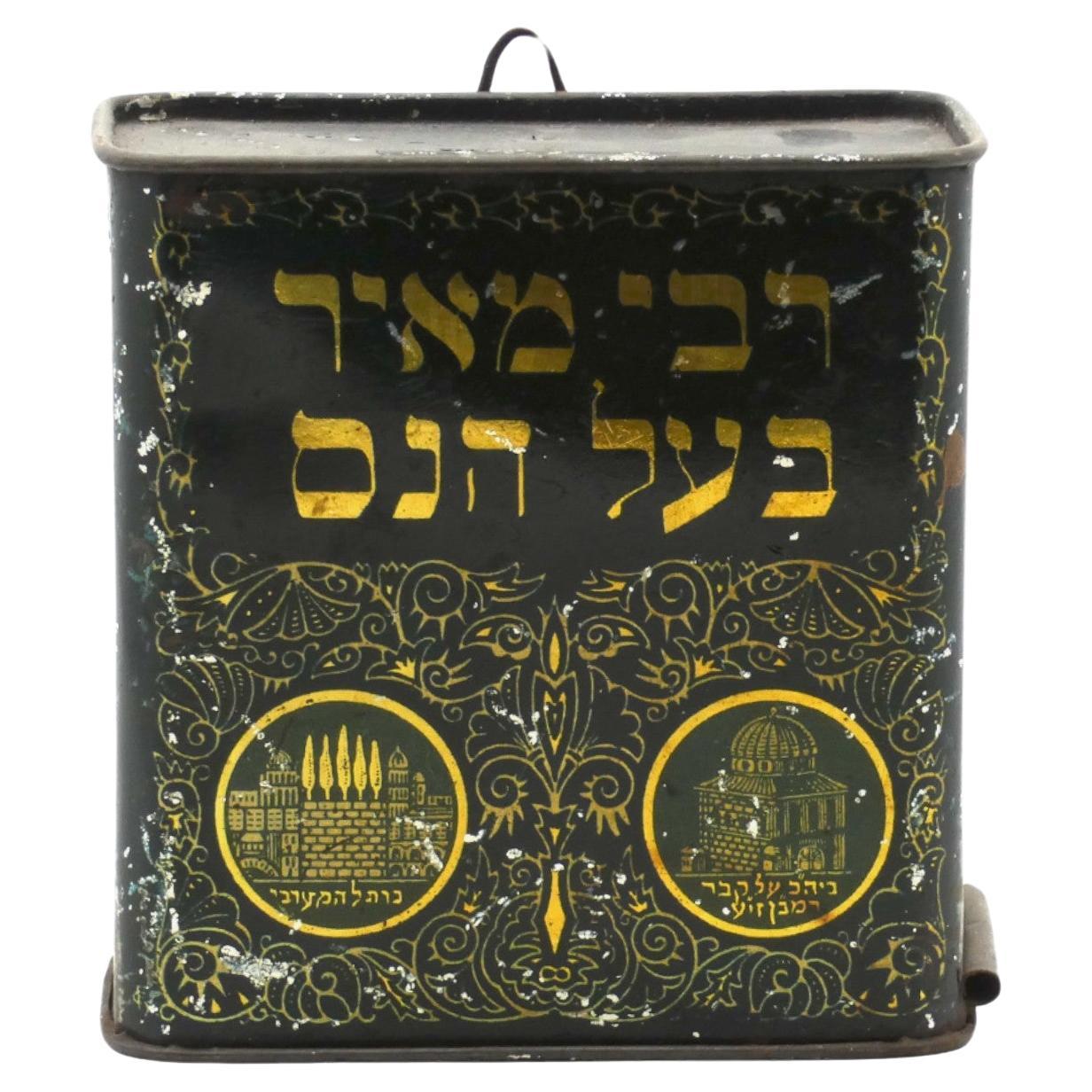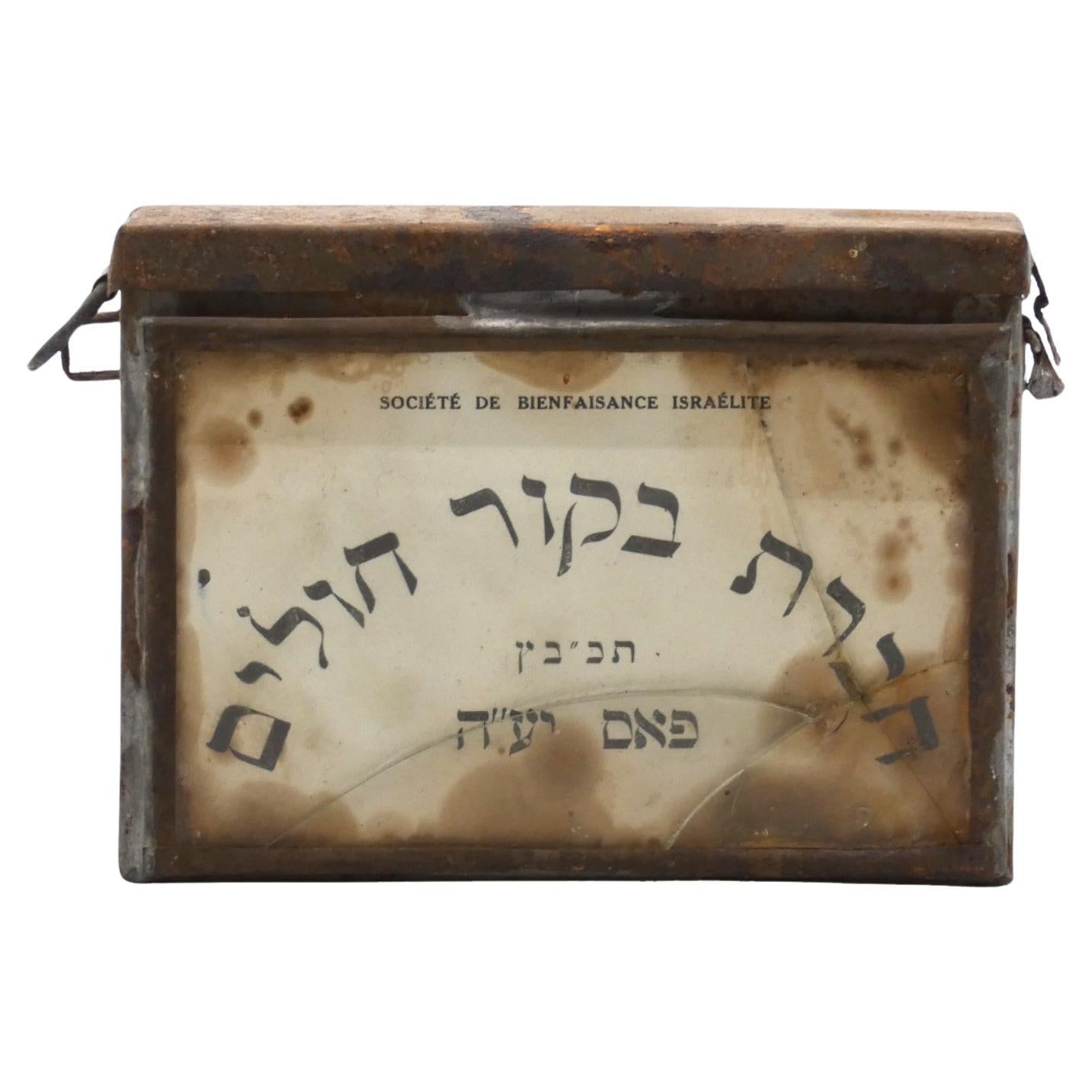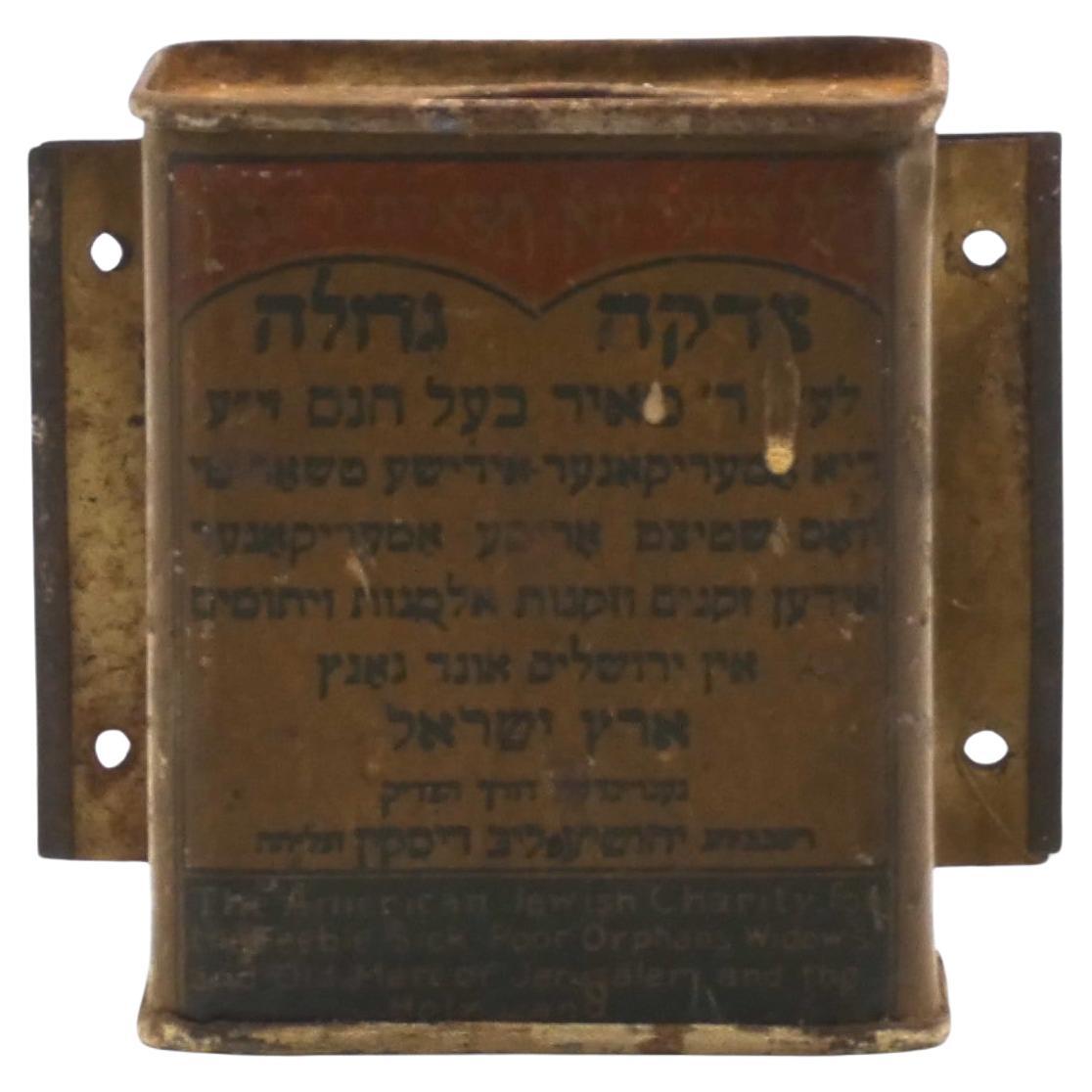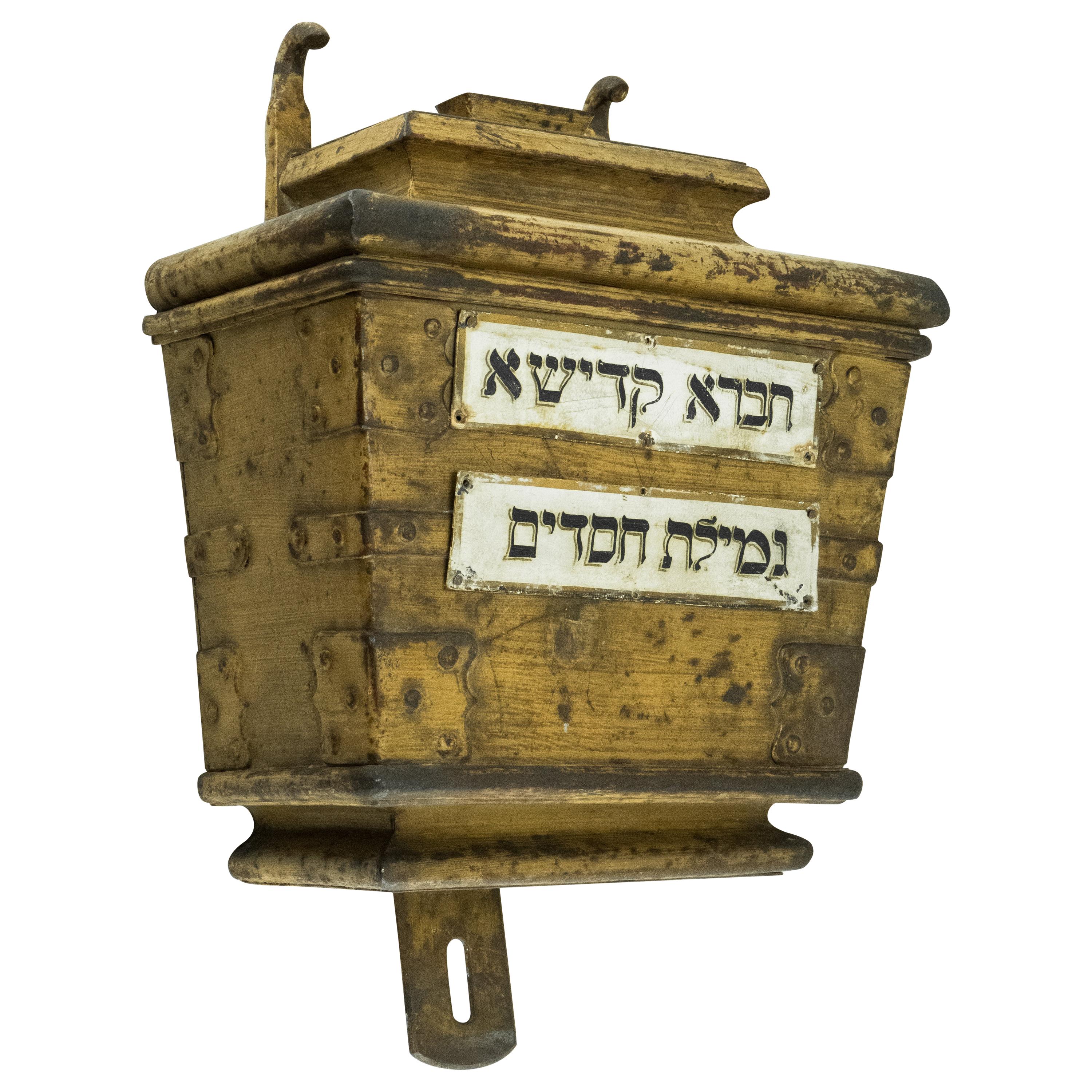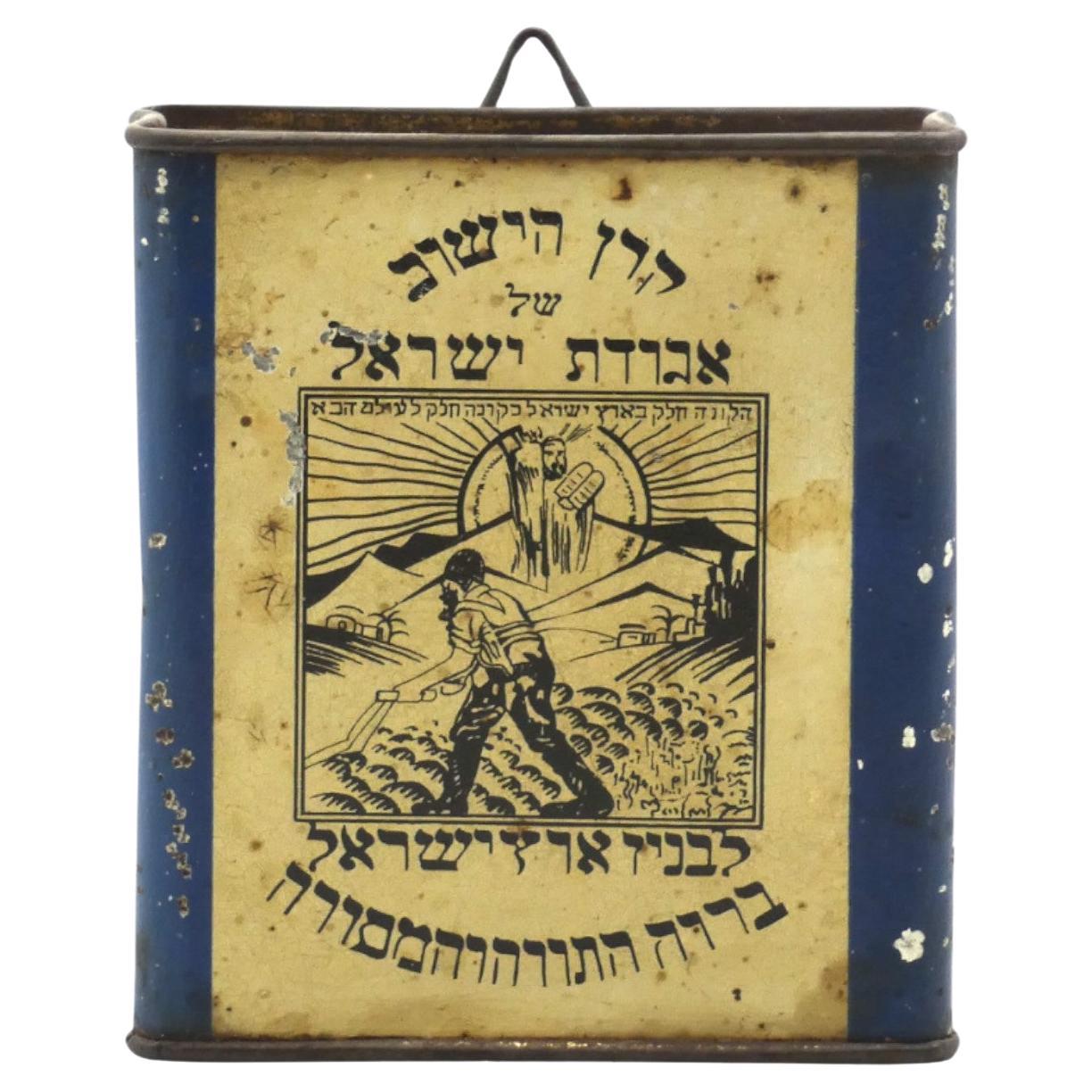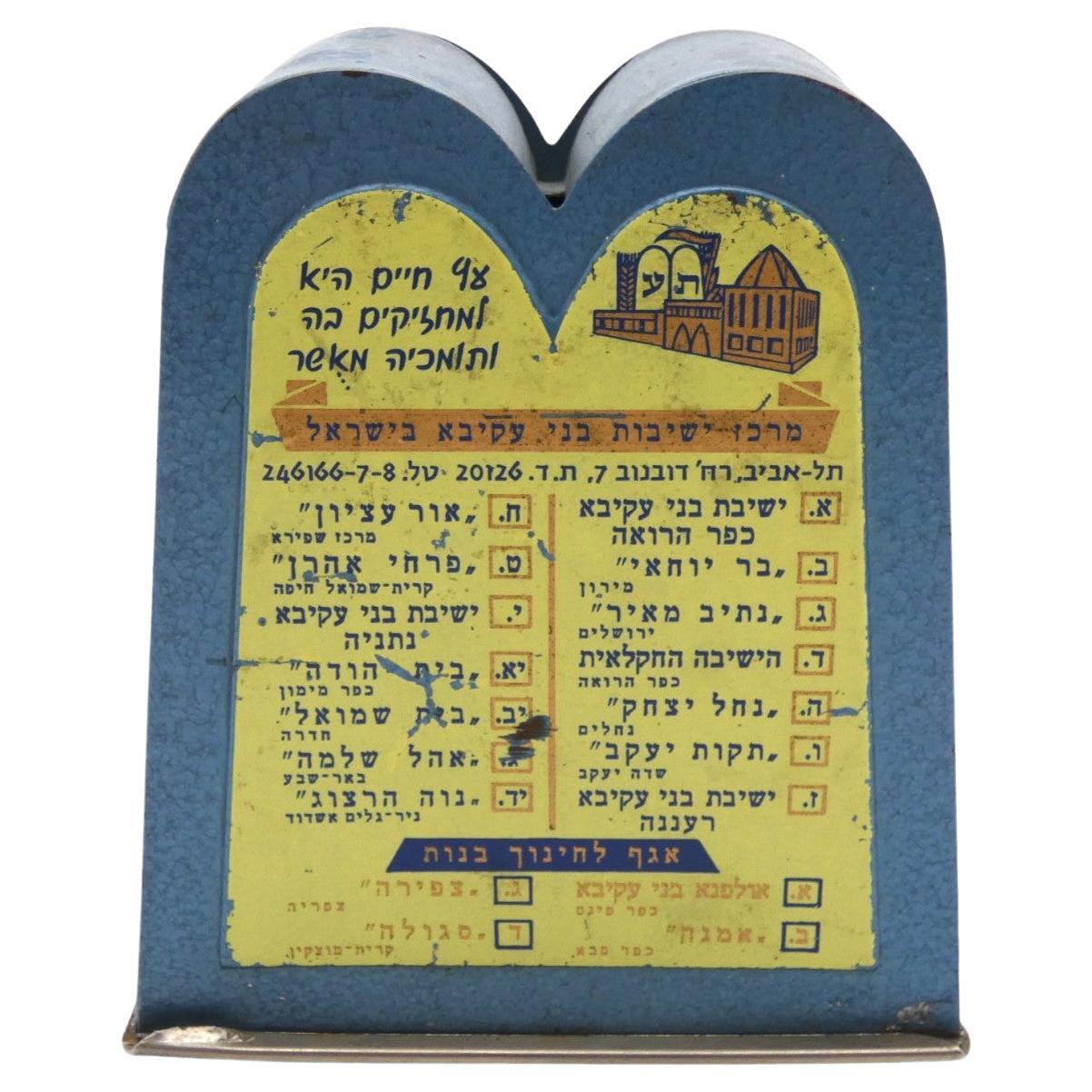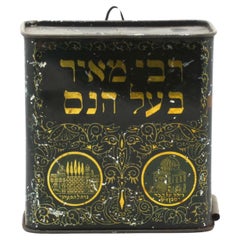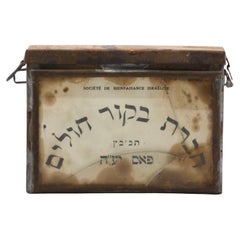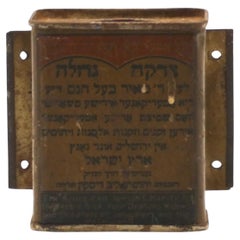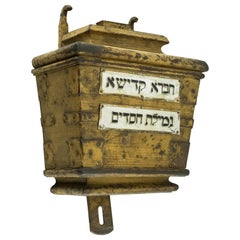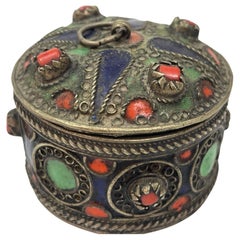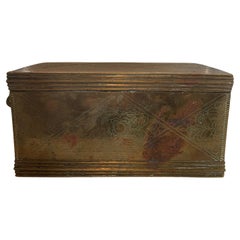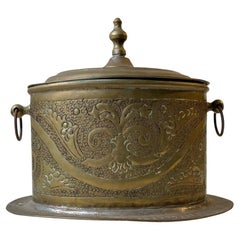Items Similar to A Moroccan Charity Container, Circa 1920
Want more images or videos?
Request additional images or videos from the seller
1 of 6
A Moroccan Charity Container, Circa 1920
$2,000
$2,50020% Off
£1,526.99
£1,908.7420% Off
€1,764.42
€2,205.5320% Off
CA$2,807.62
CA$3,509.5320% Off
A$3,129.39
A$3,911.7320% Off
CHF 1,641.88
CHF 2,052.3520% Off
MX$38,214.91
MX$47,768.6420% Off
NOK 20,789.79
NOK 25,987.2420% Off
SEK 19,649.52
SEK 24,561.9020% Off
DKK 13,168.67
DKK 16,460.8420% Off
About the Item
This Moroccan charity container from around 1920 is a unique artifact that represents the containers that were often used for collecting donations or contributions for various charitable purposes within Moroccan communities.
Seemingly this charity container was not mass-produced and not distributed worldwide from looking at the materials used to create it, and by the inscription placed within. It was made locally to support poor families, invalids, hospitals, and local communal funds needed in that particular community in Morocco.
Printed on a slip of paper inserted into the front glass of the container: "This Charity container is approbated by the Holy Scholar who is learned in the ways of miracles, Rabbi Shlomo Balchanes". Underneath, the inscription continues to give a blessing to all who donate to the cause. At the bottom, the name of the religious leader of that community is written in Hebrew.
Made of tin in a rectangular shape a glass window protects the slip of paper inscribed within with a cover that fits onto the main body and a latch at its side for securing purposes. A triangular ring is attached at the back and used for hanging in communal areas.
The early 20th century in Morocco was a period of significant change, with the country transitioning from a time of colonial influence to asserting its own cultural identity and independence. This Moroccan charity container is a testament to the charitable traditions and craftsmanship of its time, offering insights into Moroccan society during a period of cultural and historical significance.
Provenance: The Willie Lindwer Collection.
- Dimensions:Height: 3.82 in (9.7 cm)Width: 5.4 in (13.7 cm)Depth: 1.97 in (5 cm)
- Materials and Techniques:
- Place of Origin:
- Period:
- Date of Manufacture:1920's
- Condition:Wear consistent with age and use. Glass is cracked at the front.
- Seller Location:New York, NY
- Reference Number:1stDibs: LU5281240029352
About the Seller
5.0
Recognized Seller
These prestigious sellers are industry leaders and represent the highest echelon for item quality and design.
Established in 2006
1stDibs seller since 2020
130 sales on 1stDibs
Typical response time: 1 to 2 days
- ShippingRetrieving quote...Shipping from: Pomona, NY
- Return Policy
Authenticity Guarantee
In the unlikely event there’s an issue with an item’s authenticity, contact us within 1 year for a full refund. DetailsMoney-Back Guarantee
If your item is not as described, is damaged in transit, or does not arrive, contact us within 7 days for a full refund. Details24-Hour Cancellation
You have a 24-hour grace period in which to reconsider your purchase, with no questions asked.Vetted Professional Sellers
Our world-class sellers must adhere to strict standards for service and quality, maintaining the integrity of our listings.Price-Match Guarantee
If you find that a seller listed the same item for a lower price elsewhere, we’ll match it.Trusted Global Delivery
Our best-in-class carrier network provides specialized shipping options worldwide, including custom delivery.More From This Seller
View AllA Rabbi Meir Ba'al Haness Charity Container, Israel Circa 1920
Located in New York, NY
A Rabbi Meir Ba'al Haness charity container from Israel circa 1920 is an artifact associated with Jewish religious devotion and charitable traditions.
Rabbi Meir Ba'al Haness, also ...
Category
Vintage 1920s Israeli Religious Items
Materials
Tin
$1,440 Sale Price
20% Off
A Glass & Tin Moroccan Charity Container, Fez 1920
Located in New York, NY
Antique glass and tin Moroccan Bikur Cholim charity container from Fez, circa 1920, is a fascinating artifact blending both cultural and historical sig...
Category
Vintage 1920s Religious Items
Materials
Tin
$2,000 Sale Price
20% Off
A Kollel America Charity Container, New York Circa 1930
Located in New York, NY
A Kollel America Tiferet Jerusalem Charity Container from New York circa 1930 is tied to the charitable activities of Jewish immigrant communities in America raising donations for ca...
Category
Early 20th Century American Religious Items
Materials
Tin
$720 Sale Price
20% Off
19th Century Hungarian Synagogue Iron Charity Container
Located in New York, NY
Large handmade iron charity container, Hungary, circa 1850.
The iron tzedakah box was installed within the wall at the Hungarian Synagogue.
On the fr...
Category
Antique Mid-19th Century Hungarian Religious Items
Materials
Iron
$15,024 Sale Price
20% Off
A Keren Hayeshuv Charity Container, Israel Circa 1940
Located in New York, NY
A Keren Hayeshuv charity container from Israel circa 1940 is an artifact tied to the early years of the State of Israel and its efforts to support Jewish settlement and development.
Keren Hayeshuv, which translates to "The Settlement Fund," was an organization established in Israel during the pre-statehood period and continued its activities after the establishment...
Category
Vintage 1940s Israeli Religious Items
Materials
Tin
A Charity Container for the Bnei Akiva Organization , Israel 1950
Located in New York, NY
A charity container for the Bnei Akiva organization in Israel from around 1950 reflects the ethos and activities of this prominent religious Zionist youth movement.
Bnei Akiva is a ...
Category
Vintage 1950s Israeli Religious Items
Materials
Metal
$1,120 Sale Price
20% Off
You May Also Like
extremely rare Algerian Judaica silver, jewish Dowry box early 19th century
Located in Tel Aviv - Jaffa, IL
Amazing and scarce JUDAICA object, we have here one of the most touching jewish objects we had for a long time, this small silver dowry box was made in Algeria in the early 19th century, it is all covered with symbols of jewish faith and of couples, the sliding lid has 2 flanking birds with hamsa (protective hand) on each side and a flower vase in the middle.
one side shows two flanking lions with a tree in the middle and the other side shows again two big and two small birds with a flower bowl in the middle, front side has a key hole and next to it there is the Hebrew inscription ס״ט״" which says Siman tov or in English "a good sign" it is taken from the wedding blessing, underneath the lock there is another inscription with the name ״עזיזה בת אברהם בן חמו״ which is the name of the bride, her father and her grandfathers name.
the box is full marked a lot of times with the silversmith mark, every side of the box is marked.
this box was probably ordered by the grooms family to hold the jewelry they are giving to the bride as dowry, this type of objects are rare and there are just a few of them on museum collections.
DOWRY (Heb. נְדֻנְיָה), the property a wife brings to her husband at marriage; the Yiddish equivalent, nadn, is from the same root. The custom of nedunyah became clearly defined and institutionalized only in the talmudic period. In biblical times, mohar (מֹהַר), whereby the groom bought his wife from her father (Gen. 24:53; Ex. 22:15–16; Hos. 3:2), was the accepted practice. It was then customary that the groom give the bride gifts, and that she bring certain property to her husband's home upon marriage: slaves, cattle, real estate, etc. (cf. Gen. 24:59–61; 29; Judg. 1:14ff.; I Kings 9:16). Evidence of the custom of nedunyah is to be found in Tobit (7:14; 8:21) and in the Assuan papyri (Cowley, Aramaic, nos. 15, 18). Gradually, mohar was superseded by the ketubbah custom according to which the husband merely assumed the responsibility of compensation to his wife in case he divorced her: he had to pay her 200 zuzim if she had been a virgin at the time of marriage, and 100 zuzim if a widow or divorcée (see *Ketubbah).
By talmudic times, the institution of nedunyah was prevalent; the father gave a dowry to the bride since the daughter was excluded from paternal inheritance. Fifty zuzim (equivalent to the worth of 180 grams of silver) was the minimum amount a father was obliged to give to his daughter (Ket. 6:5). Parents usually gave much more, according to their social standing. Community funds provided the dowry for an orphan or a very poor girl (ibid.; cf. Sh. Ar., YD 251:8). In case of her father's death, the brothers of a minor girl were obliged to give her the minimum dowry, and the court estimated how much her father would have given her above the minimum dowry. The sum was then taken out of the father's estate and given to the daughter upon majority (Ket. 6:6; 68a–69b). In the absence of such an estimate, each daughter was entitled to receive one-tenth of the value of her father's estate in money, or in valuables (Yad, Ishut, 20:4–7; Sh. Ar., EH 113:4). If the father was unable or unwilling to pay the promised dowry at the betrothal ceremony, the groom could refuse to marry his bride (Ket. 13:5; Ket. 108b–109a). Insistence on exact payment of the promised dowry, however, was frowned upon by later rabbinic authorities (Rema to Sh. Ar., EH 2:1). In certain communities it was customary for the groom's father to make a dowry contribution equal to that of the bride's father (Ket. 102b). The dowry, whether given in real estate, slaves, money, or chattel was recorded in the marriage contract (the ketubbah) and in some instances one-third or one-fifth of the actual value of the dowry was added to the sum mentioned in the ketubbah. Based upon a decree enacted by *Simeon b. Shetah (first century C.E.), the Talmud ruled that the husband and his entire property were liable for compensation as stipulated in the ketubbah, either in case he died (when she collected the sum specified in the ketubbah from the heirs) or in case he divorced his wife (Ket. 82b). For the status of the dowry and the husband's rights and obligations, see below. The rabbinic enactments (Takkanot Shum) by R. Jacob *Tam and by the rabbinic synod of the communities of Speyer, Worms, and Mainz (Germany) stipulated that if a woman died...
Category
Antique Mid-19th Century Algerian Tribal Art
Materials
Silver
Antique Handcrafted Vintage Berber Kabyle Box Africa Algeria 1920
Located in North Hollywood, CA
Antique Handcrafted Vintage Berber Kabyle Box.
Handcrafted vintage North Africa.
Algeria Berber Kabyle box crafted in nickel silver in traditional style of red and green enamels and ...
Category
Early 20th Century Algerian Islamic Decorative Boxes
Materials
Silver, Enamel
Antique Qajar Iran Lidded Box
Located in LOS ANGELES, CA
Antique solid brass lidded box from Qajar Iran, c. 20th century. Absolutely stunning piece with beautifully intricate engraving detail throughout. A diamond engraved pattern runs thr...
Category
20th Century Persian Decorative Boxes
Materials
Brass
Antique Moroccan Tea Caddy in Brass, 1900s
Located in Esbjerg, DK
Late 19th or early 20th century Teacaddy in Hand engraved and embossed brass. Great rich patina that along with its details give it a certain charm. It has a hinged lid that works ju...
Category
Antique Early 1900s Moroccan Late Victorian Tea Caddies
Materials
Brass
$349 Sale Price
25% Off
Antique German Humidor
Located in Tampa, FL
A wonderful antique German humidor. Mostly copper with some metal and a wood interior. The interior is about 3" deep. there isn't a key. Circa 1890s.
Category
Antique 1890s German Decorative Boxes
Materials
Metal, Copper
19th Century Chinese Export Tea Caddy
Located in Charlottesville, VA
A black lacquered tea caddy. Great decoration and has interior compartment.
Category
Antique 19th Century Chinese Tea Caddies
Materials
Wood, Paint
More Ways To Browse
Antique Container
Antique Containers
Antique Furniture Containers
Antique Glass Container
Antique Glass Containers
Moroccan Window
Scholar Antiques
Oak Church Doors
Carved Tabernacle
Church Crucifix
English Bible
French Antique Font
French Reliquary
Religious Niche
Religious Santos
Mid Century Crucifix
Antique Nativities
Hand Carved Wood Crucifix
